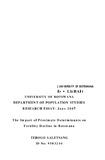| dc.description.abstract | This study attempted to identify the proximate determinant o f fertility that contributed most to fertility change in Botswana using the 1984, 1988 and 1996 Botswana Family Health Survey Data (BFHS). Also, the research attempted to establish the trend in contribution of each proximate determinant of fertility to fertility change. Furthermore, the study intended to asses the similarities/differences in the
contribution of proximate determinants of fertility-to-fertility change in Botswana and in selected (Zambia, Zimbabwe, Zambia and Namibia) sub-Saharan countries. The contribution of each of the proximate determinants of fertility to fertility change was decomposed using FAMPLAN computer program. FAMPLAN program is based on the Bongaarts framework of proximate determinants of fertility. The results indicate that, among the principal proximate determinants of fertility, during BFHS I (1984), postpartum insusceptibility had the most fertility inhibiting effect. However, during BFHS II and BFHS II, the risk of exposure to pregnancy contributed most to fertility change. Postpartum insusceptibility had the second highest fertility inhibiting effect while contraception had a mild effect on fertility change. Moreover, the results show that Botswana differs from other sub-Saharan countries in that fertility change in Botswana was largely influenced by the risk of exposure to pregnancy, while in other countries, postpartum insusceptibility had more influence on fertility change. | en_US |

